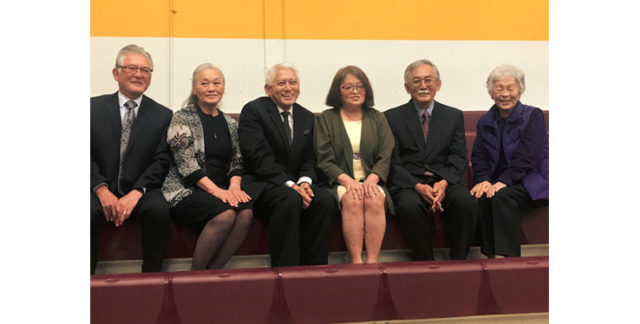
For Japanese people, the family name Matsudaira immediately brings a connection to the Tokugawa Shogun family. Hearing that Martin “Mich” Mitsuyuki Matsudaira passed away in March 2019 at the age of 81, I became quite interested in the family history of the Matsudairas in Seattle. I was able to learn about the family history from Mich’s siblings, their nephew Peter Matsudaira and Mich’s daughter-in-law Yuka Matsudaira about their family history.
The Matsudaira ancestor who came to Seattle was Tokuhisa Matsudaira (1892-1967). He first arrived in Seattle in 1909 to join the Alaska-Yukon-Pacific Exposition that was held on the present day University of Washington campus. Tokuhisa was from Kanazawa City, Ishikawa Prefecture (formerly known as Kaga Domain), and descendant of Yasusada Matsudaira (see article about Yasusada on p.8). He was a student at Kanazawa Daini High School at the time and at the age of 16, he was hired by a Kutani-yaki (a kind of porcelain which was locally from Kaga) merchant who had a booth at the expo. The Alaska-Yukon-Pacific Exposition was a world’s fair held to attract people from Seattle and throughout the United States and the emerging Seattle and Pacific Rim countries. The Japanese government, in addition to Canada, hosted the Japanese Pavilion. This pavilion also drew a business team led by Eiichi Shibusawa to promote a Japan-U.S. economic relationship. Shibusawa was a banker, entrepreneur and government officer who is widely known in Japan as “father of Japanese capitalism.”

Young Tokuhisa became fascinated with baseball during his stay in Seattle. He pitched for one of America’s first Japanese pro baseball teams and was nicknamed “Golden Arm”. He decided to stay here after the exposition ended. He worked for a jeweler Hardy Trading and as an elevator operator at the Lincoln Hotel. But his baseball career ended when he lost an eye in elevator accident.
More than ten years after arriving in Seattle, in 1921, Tokuhisa returned to Kanazawa. He met his future wife Hotoru (1902-1996) through his relatives, married her in Kanazawa, and brought her back to Seattle with him.

Hotoru, also from Ishikawa Prefecture, was a person with a strong sense of mission and many skills. After graduating from high school, she worked at a bank in Kanazawa, and later, during the Spanish Flu epidemic in 1918 and 1919, she delivered medicine to homes of people who were not able to receive hospital care.
Tokuhisa and Hotoru eventually acquired English names: Thomas and Theresa. By 1948, they had 14 children. (The only child born in Japan – Akira – died in infancy and is entombed at the Myokeiji Temple in Kanazawa.)
Following Japan’s attack on Pearl Harbor, the Matsudairas were among the 120,000 persons of Japanese descent who were forcefully removed from their homes in the western United States and imprisoned in camps until the war ended in 1945. The oldest Matsudaira son, John Takehisa volunteered to fight alongside members of the famed 100th/442nd Regiment and was awarded the Purple Heart for near-fatal wounds suffered during combat in Italy. He eventually became famous for his art, recognized as among the top Northwest painters.
Michael Yoshihisa, the second of the Matsudaira boys, joined the Military Intelligence Service and served with the U.S. Army Occupation force in Tokyo. He was later joined by the third brother Francis Teruhisa, stationed in Yokohama. All nine Matsudaira men served in various branches of the U.S. military, arguably the most to serve from a single family.
The eighth child, Martin Mich left his Boeing economist job to become the first executive director of the Commission on Asian Pacific American Affairs (CAPAA) in Washington State. He was devoted to bringing improvements to the Japanese American community.
Like many Seattle Issei who had converted from Buddhism to Christianity, Thomas and Theresa eventually converted to Christianity, and in 1952, the devoutly Catholic Theresa was awarded the prestigious National Catholic Mother of the Year title.
The legacy of the Seattle Matsudairas, as initially recorded in the memoirs of Hotoru, continues into the fifth generation of Japanese Americans, through traditions such as welcoming the Oshogatsu (New Year) with osechi (specially prepared food); studying Japanese language and customs; performing Japanese dance and musical instruments, and of course, participating in the local Japanese festivals.






